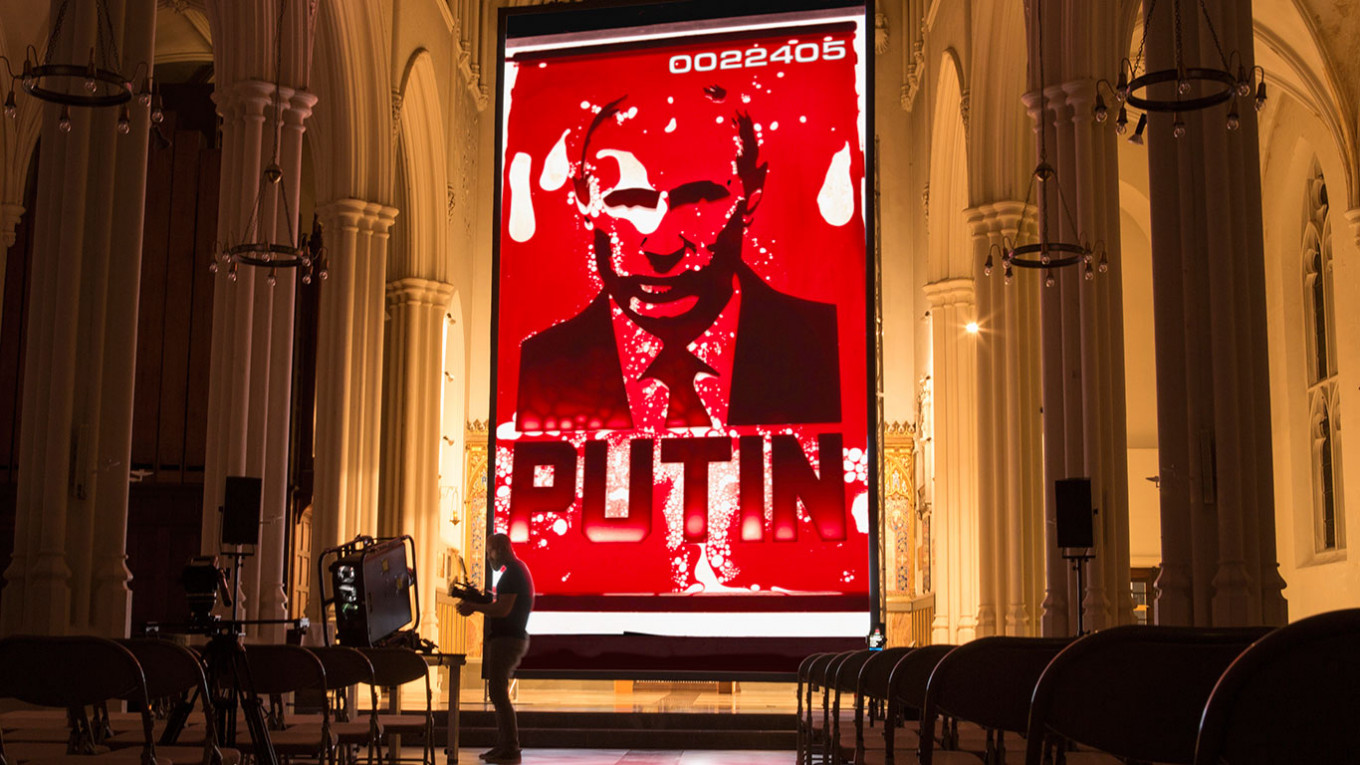Andrei Molodkin, a Russian conceptual artist famous for using human blood and crude oil in his bold mixed-media installations, spoke out against Russia’s invasion of Ukraine through the medium he knows best.
Molodkin created a portrait of Russian President Vladimir Putin using real blood as a graphic condemnation of Putin’s regime and Russia's “special military operation” in Ukraine, which began on Feb. 24. He named his newest work “Putin Filled with Ukrainian Blood.”
An eight-meter-high projection of the portrait was installed briefly as an icon at the altar of a church in central London on Wednesday.
The blood was donated by Molodkin’s Ukrainian friends and co-workers living with him at the Foundry in France, described by Molodkin’s Studio Manager Anthony Martin as “an enormous industrial building complex that has become a home for the radical underground.”
After donating blood, Molodkin’s friends went back to Ukraine to fight the Russian army, which has been pounding the country for three weeks.
“I had to return to defend my homeland. I gave my blood before I came to fight to show whose blood is being spilt at the hands of one man,” a blood donor named Oleksandr Turchynets said via text from outside Lviv.
Wives and children of the men who had donated blood fled the war and are now living in Molodkin’s quarters at the Foundry.
Commenting on the installation, Andrei Molodkin said: “I created this work as an act of solidarity between the Russian and Ukrainian people. It’s the dream of any criminal regime to silence discussion. It’s time for us to use art to send a clear message about war and who Putin really is.”
“Putin Filled with Ukrainian Blood” consists of an acrylic block that encloses a portrait of the Russian president. ‘Putin’ is written in the bottom of the block. The outlines of the text and image are painted with blood. While minimal, the red strokes graphically convey the features and expression of the subject.
In the installation, blood starts slowly running down the block, bubbling as it fills the empty spots in the frame, all to the sound of heart beats.
Born and raised in the Soviet Union, Molodkin served in the Soviet Army delivering oil in Siberia. The artist first thought of using blood as an artistic tool when he witnessed a fellow soldier shoot himself in the heart.
Molodkin has created several powerful and politically charged works of art using blood.
His 2009 “Le Rouge et le Noir” installation pumped the blood of a Russian veteran of the Chechen War through acrylic replicas of Nike of Samothrace, the Greek goddess of victory, which stood atop blocks filled with Chechen oil.
Controversy ensued when the curator censored the work the night before the public opening and prohibited Molodkin from communicating with the press.
Part of the exhibition was taken down.
Anthony Martin, who has worked with Molodkin for many years, told the Moscow Times that they have had to fight against censorship for every project and exhibition.
Molodkin’s “The White House Filled With the Blood of U.S. Citizens” (2020) was banned from being shown in Washington D.C. last year, and his 2013 exhibition “Catholic Blood” nearly closed the night before the opening in Northern Ireland.
“Andrei is an ex-militarist and knows that corrupt, criminal regimes pay with the blood of their citizens,” Martin said.
“This portrait of Putin captures the time we are living in. In London we decided to only show it for a short time. It will be shown in other cities around the world over the next month or so.”
A Message from The Moscow Times:
Dear readers,
We are facing unprecedented challenges. Russia's Prosecutor General's Office has designated The Moscow Times as an "undesirable" organization, criminalizing our work and putting our staff at risk of prosecution. This follows our earlier unjust labeling as a "foreign agent."
These actions are direct attempts to silence independent journalism in Russia. The authorities claim our work "discredits the decisions of the Russian leadership." We see things differently: we strive to provide accurate, unbiased reporting on Russia.
We, the journalists of The Moscow Times, refuse to be silenced. But to continue our work, we need your help.
Your support, no matter how small, makes a world of difference. If you can, please support us monthly starting from just $2. It's quick to set up, and every contribution makes a significant impact.
By supporting The Moscow Times, you're defending open, independent journalism in the face of repression. Thank you for standing with us.
Remind me later.






